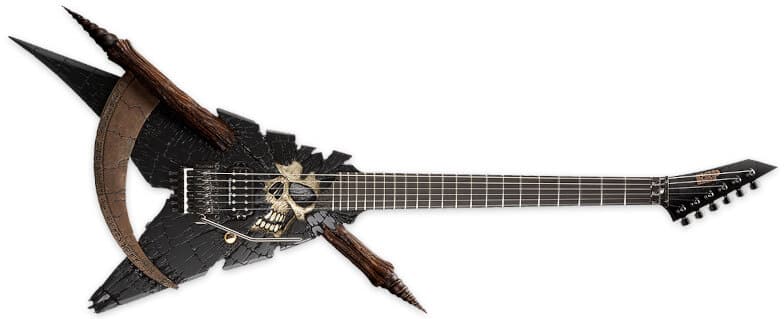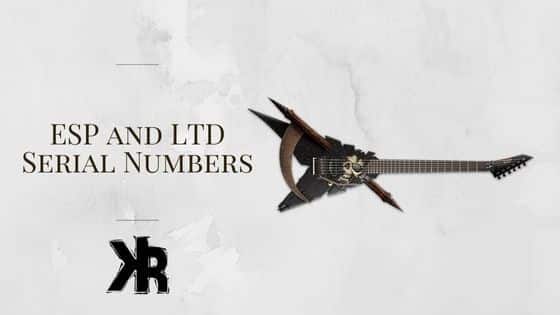Table of Contents
ESP is a popular guitar brand. They are known for making some amazing metal guitars. Because of their quality, players collect them, as each one has specific features.
But how can you tell where they are made or even their age? This is where ESP serial number decoding becomes handy!
In this Killer Rig article, we are going to look at their serial numbers and see what they mean.
This is a great way to find out more information. But it’s also a great way to tell if the instrument is real or fake! This is important when planning on buying a used ESP guitar.
What are ESP Serial Numbers?
ESP guitar serial numbers are unique codes. They are factory codes given to guitars to signify manufacturing date and location.
These numbers are assigned to each instrument they make. Then they are applied before they leave the factory. If you can decode the serial number, you can also tell if it’s an authentic guitar.
There isn’t much information on older ESP guitars, as the records were not clear. Guitars seem to have been given random codes that didn’t mean much at the time. Some even left the factory without any serial numbers at all!
But at some point, ESP got it together and started to keep proper records of their guitars. If you have a newer instrument, then your serial number will be beneficial.
You can find out all you need to know, even the batch number! If you put your detective skills into action, you will find what you are looking for!
Have guitars that need decoding from another manufacturer? We have more tools here:
Where are the Serial Numbers Found?
ESP guitars made before the year 2000 had the serial numbers placed in many different places. Most of them had serial numbers placed on the back of the headstock.
This seems to be the common place for them. But there were some that had the numbers placed under the pickups.
This seems very common with neck through models. If you can’t find your serial number, you might check there. Some other places they put factory codes were the neck joint, or heel.
For bolt on necks, you may get lucky and have a plate with the serial number punched into it.
Guitars made after the year 2000 all seem to have the codes on the back of the headstocks. This is when ESP got serious about their codes and kept things uniform.

Early ESP Guitars
As was mentioned earlier, ESP didn’t keep good records of serial numbers on early guitars. If you have an older ESP, you may not get the information you seek.
Part of the reason for the lack of information was due to a factory fire. In the late 1990s, the ESP factory in Japan experienced an accidental fire.
This blaze destroyed a portion of the factory, but also the serial number records that they did have. As a result, they are lost!
ESP has confirmed that they did not keep a good tracking system in the early days. And even they are not sure what the serial numbers mean.
If you are lucky and still have the warranty card, you will be in luck! They had the information on them directly.
Understanding ESP Serial Numbers
ESP guitars are made in Japan. As such, you already know the place of origin. Unless your guitar is an LTD model. In this case, they are made in Korea and Indonesia.
This can be found in the serial numbers.
Guitars Made Before Year 2000
If your guitar is older than year 2000, then it will normally have 7 or 8 digits for a serial code. This will be all numbers are no letter designator like newer guitars.
From what we understand, this tell us the date of manufacture as well as the production number. This table will help you understand them.
| First Digit | Second and Third | Fourth | Remaining Digits |
|---|---|---|---|
| Day | Month | Year | Production Number |
| 01 to 31 | 01 to 12 | Last digit of the year | Guitars made |
While this seems to make sense, ESP changed the way they applied the codes randomly. In some cases, you may find that the first and third numbers are missing if they were a zero.
This can make things more complicated as a result. If your code has 6 or 7 digits, then one of them was probably removed as it was a zero. So you will need to account for this when trying to decode it.
Code in Neck Joint
If your code has been found in the neck joint, here is how to understand it. They are normally only 5 numbers. It displays the month and year, plus the lot number.
| First Two Digits | Third Digit | Remaining Digits |
|---|---|---|
| Month | Year | Production Number |
| 01 to 12 | 2 = 1992 | Batch Code |
Codes on Metal Plates
If your code is a 5-digit number found on a neck plate, this is different. According to some research I conducted, they seem to use a different system. They all seem to just be a batch number that was reset each year. Even then, there is little to go on.
| Year | Serial Number |
|---|---|
| 1992 | 60101 to 61899 |
| 1993 | 61901 to 91299 |
| 1994 | 16601 to 18399 |
| 1995 | 19101 to 24499 |
| 1996 | 25701 to 26199 |
| 1997 | 27301 to 29499 |
| 1998 | 30101 to 35799 |
| 1999 | 33901 to 36999 |
Year 2000 to 2015
Around this time, ESP began implementing a new system. This one began to keep better records of where the guitars were made and when. It was so specific, it even tells us the factory name!
These are not the LTD line of guitars, these were all made in Japan. You will find that the code begins with a letter to designate the factory. It’s then followed by 7 digits.
Factory Prefix
There are a number of factories that were used to make ESP guitars. This was marked as a letter at the beginning of the serial number. These are the factories and the letter that was used to designate them:
- K = Kiso.
- N = Nagano.
- CH or CS = Craft House.
- S = Sado.
- T = Takada.
- TH = Technical House.
7-Digit Code
The remaining digits then tell us the day, week, year and the number of guitars made that day.
| First Two Digit | Third and Fourth | Fifth | Remaining Digits |
|---|---|---|---|
| Year | Week Number | Day of the week | Production Number |
| 00 to 15 | 01 to 52 | 1 = Monday. 7 = Sunday. | 01 to 99 |
Year 2015 to Present
From 2015 to the present day, the ESP guitars have the same serial numbers. They are a letter plus 7 digits. But what they are used for has changed. This is because ESP makes more guitars and do things different now.
| Letter | First Four Digits | Fifth and Sixth Digits | Last Digit |
|---|---|---|---|
| Brand Designator | Production Number | Year | Series |
| E = ESP. ES = E-II. | Guitar batch number | Last two digits of the year | 1 = Custom Series. 2 = Original Series. 3 = E-II Series. |
As you can see, the serial numbers are much different from the previous arrangement. An example code of E1547202 would mean It’s an ESP Original series made in 2020. It’s also guitar number 1547 of the total batch.
ESP USA
There are a few USA made ESP guitars as well. They come with the prefix US and are made in California. The serial number only consists of 5 digits.
The first two denote the year it was made. The last three are not known, but might just be the build number.

Understanding LTD Serial Numbers
The LTD line of guitars are also produced by ESP. But they are not made in Japan. These guitars are made in China, Korea and Indonesia.
There are a few well known factories in these countries. They are responsible for making most of the guitars that come from this part of the world.
Each factory has a letter that is used in the serial numbers. Sometimes there are more than one letter to also include the country or origin.
The remaining digits will be either 7 or 8. This will tell us the year of manufacture as well as the build number.
You will find that if the serial number has 7 digits, it was made somewhere between 2000 and 2010. From what I understand, after about 2010, they started to use 8 digits.
LTD Factory Code Numbers
The digits are used to denote the year, month and number of guitars produced. These all seem to be the same no matter where the instruments are made.
The table below does not include the letter prefix. Those we will see later on. Here is what the numbers mean:
| First Two Digits | Third and Fourth | Remaining Digits |
|---|---|---|
| Year | Month | Guitar Lot Number |
| 01 = 2001. 21 = 2021. | 01 = January. 12 = December. | Build Order. |
Factory Prefixes
The letter used to start a serial number denotes the factory it was produced in. This spans a great many countries. Here is the information we have.
Indonesia
Many companies have guitars that come from Indonesia. And most of them are made by the same factories. LTD is no different, which makes it easy for us to see who made them. Here are the letters you will find in the serial numbers and the factories they represent.
- IW or W = P.T. Wildwood.
- C or IC = Cor-tek.
- S or IS = Samick.
China
There are also a number of models made in China. Some of the prefixes were only used to indicate that the guitar was made in China. Others were used for the factory. But not a lot is known about the prefixes used on LTD guitars from China.
These are just guesses. Based on how other guitar companies have used their factory prefixes. Here are some of the factory codes and what we think they mean.
- L = Used to indicate it was made in China.
- RS = Possibly Wildwood.
- SH = Might be SaeJun.
Korea
There is better information available about the factories located in Korea. Manufacturers use these builders more often because of the quality they provide. Here is what the letter in the serial numbers mean:
- W = World Music Instrument.
- IR = Peerless.
Vietnam
There are a few guitars that have been made in Vietnam. But there isn’t much information available. The factory prefix is the letter I.
But the factory is unknown. The digits that follow it seem to still provide the same information that we provided earlier. But that’s all we know.
Contacting ESP Directly
If you are still not able to get the information you need, you can contact ESP directly. They will try and help you get the information you need. Provide them with the serial number and pictures of the front and rear of the guitar.
They will then be able to gather the data by cross-referencing models. This is especially helpful with older ESP guitars. Because there is very little to go on, this can be extremely helpful.

